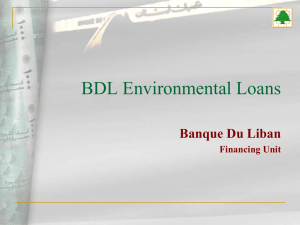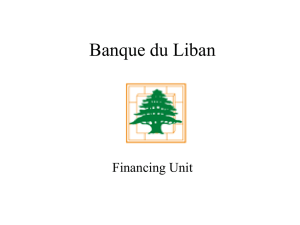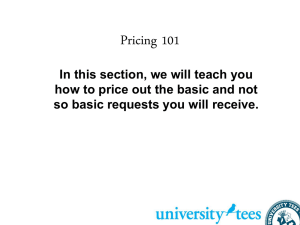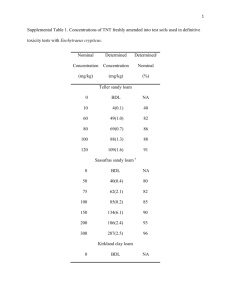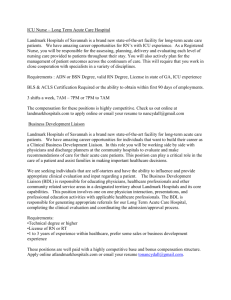02 Annual Business Debtline Impact Report
advertisement
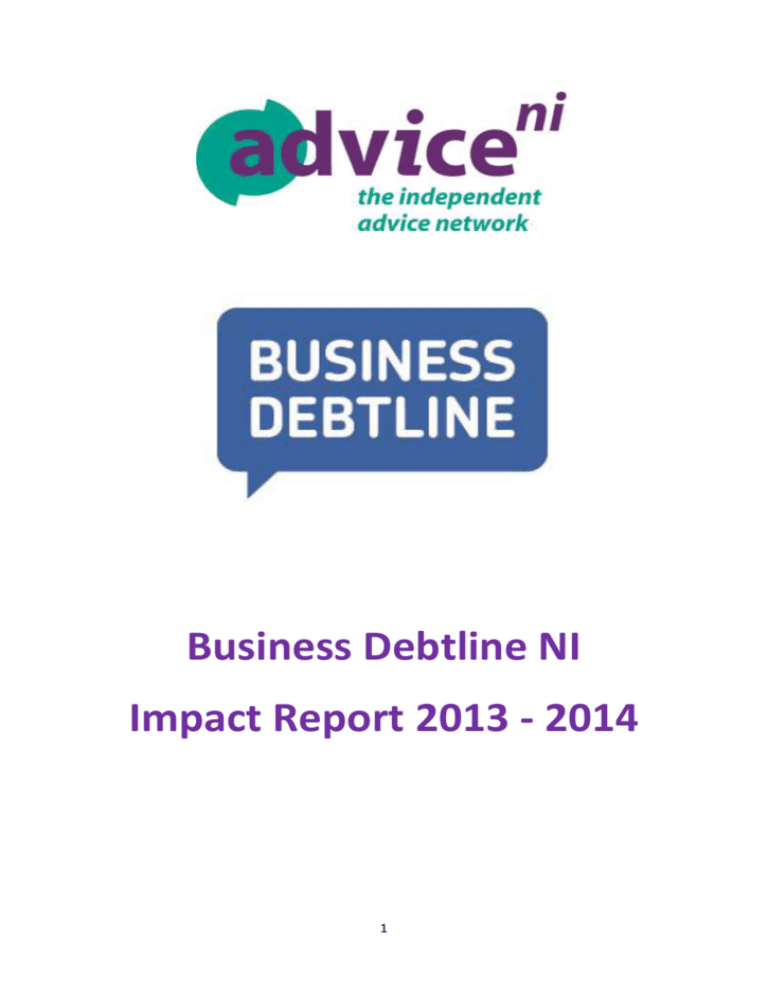
Business Debtline NI Impact Report 2013 - 2014 1 CONTENTS 1.0. Introduction 2.0. Executive Summary 3.0. Client Profile 4.0. Client Survey Feedback 5.0. Conclusions 6.0. Case studies 2 1.0. Introduction Recognising the need for free business debt advice in Northern Ireland, Advice NI was pleased to secure funding in 2013 from the Money Advice Trust to provide the Business Debtline Service (BDL) in Northern Ireland. Prior to the launch of the BDL, statistics compiled by the Northern Ireland (NI) Chamber of Commerce revealed that the threat posed to business stability by bad debts was an increasing problem. The report found almost 2 in 5 local businesses did not have a system in place to protect their business from bad debt, and 31% of local business owners had seen an increase in the level of bad debt in their business in the last year. Whilst there are signs of economic recovery within NI, albeit slow, it is unlikely that many small local businesses in Northern Ireland will experience a significant upturn in their financial situation for some time. According to government statistics, private sector wages in NI are 18% lower than the UK average and 55% lower than the average NI public sector wage. The NI economy is dominated by small and medium enterprises that rely too much on lower value activities. These smaller firms lack the resources needed to drive innovation and exports. The number of NI Business start-ups remain lower compared to the rest of the UK. Since 2010, the government has reported a 10% decline in the private sector. With the imminent introduction of welfare reform and the prospect of future interest rate rises, combined with the lack of access to affordable credit for many businesses, the financial situation for many local traders remains turbulent. The BDL service commenced operation in June 2013 with the recruitment of the adviser, and was officially launched at Stormont in September 2013 by Arlene Foster, MLA for Enterprise, Trade and Investment, Joanna Elson Chief Executive of the Money Advice Trust and Bob Stronge, Chief Executive of Advice NI. 2.0. Executive Summary BDL is primarily a telephony service, offering self-assisted advice through self-help guides and templates. The adviser also provides email advice and, in exceptional circumstances, will aid the client with creditor negotiations. BDL assisted 323 clients from 1 June 2013 to 31 March 2014 and dealt with 1,000 calls during this time. The vast majority of clients had debts in the region of £15,000 - £50,000. There were four main business sectors that required assistance – retail, construction, manufacturing and businesses providing services. The geographical analysis of clients seeking advice showed that the majority (59%) came from County Antrim and County Down. According to statistics from the Department of 3 Finance and Personnel (DFP), this is indicative of where most of NI’s private sector is located, with these two Counties having the largest proportion of all businesses. Note that Belfast is situated in County Antrim with parts of east and south Belfast in County Down. Advice NI has actively promoted the service which included meetings with key organisations to establish referral networks. The majority of referrals were made by Debt Action NI, followed by the Internet and local Citizen Advice Bureaux (CAB). Advice NI has built a relationship with Invest NI who has included the BDL service details on their website, contributing to the increase in internet referrals, and going forward BDL will provide support at Invest NI events for established businesses. From the client feedback, all respondents (100%) said that they found the overall quality of the service excellent and that they would use BDL again or recommend it to others. Advice NI considers this as a testament of how effective clients have found BDL at helping them with their financial difficulties. A total of twelve BDL self-help factsheets were developed, on a wide range of topics including business rates, business leases, sole trading, limited companies, partnerships, budging, tax, income tax, credit control, statutory demands, Individual Voluntary Arrangements (IVAs) and bankruptcy. These factsheets are currently available on the National Debtline, Advice NI and Debt Action NI websites. From client feedback, only 3% of respondents did not use the factsheets; of the 97% who used the factsheets, 95% found them very useful and the remaining 2% found them useful. From the evidence gathered through the BDL service, sole traders need the most support as they often have limited resources. This group accounted for 71% of the feedback received. This is reflective of the composition of NI’s private sector, as nearly half of all NI businesses are deemed as ‘sole proprietors’. Interestingly, 98% of BDL respondents who continued to trade would be classed by government as a micro business with < 10 employees. (Source: Inter-Departmental Business Register; DFP; 2013). Most notable from the client feedback is that over two thirds (68%) of clients said they would continue to trade with the advice provided by BDL. The majority of respondents (54%) said the most common outcome they were aiming for was a formal debt option, i.e. Debt Relief Order, IVA or Bankruptcy. This was followed by those who wanted to set up a Debt Management Plan, organise their own debt repayments or ask creditors to hold action until the situation improves, with 42% each. However, upon reviewing the evidence, the results of this question do not show a single outcome for each response as the question allowed respondents to tick multiple choices. 4 3.0. Client Profile The number of clients using the service steadily increased quarter on quarter. To date, BDL has supported 323 clients and 1,000 calls were handled by the service. The average amount of times a typical client contacted the service was three, while the busiest time for calls was during 3 – 4pm. BDL records the reasons why clients contacted BDL, which is represented in Table 3.1: Table 3.1 shows the reasons clients contacted the service Bad Debts Bank Issues Business Leases Business Rates Disputes HMRC / Tax Issues Insolvency / Bankruptcy Personal Creditors Personal Guarantee's / Ltd Co Debts Trade Creditors Court Other Creditors % 7 13 3 7 4 15 18 13 6 8 4 2 Nearly one in five (18%) contacted BDL because of Insolvency/Bankruptcy issues, 15% contacted because of HMRC /Tax issues, 13% contacted with Personal Creditor Issues and Bank issues. Only 2% contacted in relation to Other Creditors. Chart 3.2 highlights the level of client’s business debts, the debt totals were categorised by groups. 5 Chart 3.2 Level of Client's Business Debts 1% 7% 9% 17% 15% <5K 5 - 15K 15 - 30K 30 - 50K 50 - 100K 100K+ 22% Unknown 30% Nearly one third (30%) of those who used the service had debts ranging from £15,000 – £30,000 and just under a quarter (22%) had debts ranging from £30,000 - £50,000, while 9% of clients had debts over £100,000. Chart 3.3 shows the business classification of the clients who used BDL. Chart 3.3 Client Business Classification Property / Land 5% Unknown / Other 6% Transportation 3% Services 12% Retail 27% Pubs / Hospitality 7% Property 8% Manufacturing 10% Finance 1% Construction 11% Arts 2% Agriculture 8% 0.0 5.0 10.0 15.0 20.0 25.0 The majority (27%) of clients classified as Retail, followed by Services with 12% and Construction with 11%. 6 30.0 Chart 3.4 shows the geographical breakdown of the clients who used BDL. Chart 3.4 Geographical Breakdown of clients who used BDL 7% 7% Co. Antrim 7% Co. Armagh 38% Co. Down Co. Fermanagh 11% Co. Londonderry Co. Tyrone 21% Unknown / Not Given 10% Over a third (38%) of clients came from County Antrim, 21% came from County Down and 11% were from Fermanagh. BDL records referral sources which help to determine the effectiveness of promotional activity. The results are represented in Table 3.5. Table 3.5 highlights how clients were referred to BDL DANI CAB Website / Web Search Word of Mouth Invest NI Other % 56 15 15 4 3 8 The majority (56%) of clients were referred by Debt Action NI, CAB and the Internet both accounted for 15% each. Word of mouth only accounted for 4% but Advice NI would expect this to increase as the reputation of the service grows. Invest NI referrals only commenced in the fourth quarter of the year; however they accounted for 3% of referrals for the year. 7 4.0. Client Survey Feedback The following evidence is based on the feedback from client surveys. 4.1. Quality of advice Advice NI is delighted that 100% of respondents: Rated the overall quality of the advice and service as Excellent Would use BDL again or recommend it to others Stated that they would rate the adviser that dealt with them as Excellent When asked if the service helped alleviate stress and worry, 97% of respondents said that they felt much better after they contacted BDL, while the remaining 3% of respondents said that they felt a bit better. No one reported feeling worse after contacting BDL. One respondent said, “I thought it was the end of the world but it was sorted out in a few phone calls and letters, and now I can stay on track with payments and get my business back on track.” A similar response was given when respondents were asked, how helpful BDL was in achieving the outcomes they were aiming for, 97% stated that BDL was Very Helpful, while the remaining 3% said it was not applicable. One respondent commented, “The adviser talked me through everything and we arranged a call back later when I had time to think. He also posted me some factsheets and they were helpful too. Overall it was very helpful.” Respondents were asked if they were happy about the length of time they had to wait before speaking to an adviser, 93% said they were Very Happy and the other 7% were Fairly Happy. Table 4.1 below illustrates how clients responded when asked to review the quality of advice they had received from BDL. 8 Table 4.1 Client responses to the quality of advice they received The advice was clear and easy to understand The advice was tailored to my situation I understand the pro's and con's of each of the options available to me After contacting Business Debtline I was clear on the next steps I had to take As a result of the advice my debt situation has improved or will improve in the future I feel more in control of my finances I am more knowledgeable about financial matters overall since contacting BDL Strongly Agree (%) 100 100 Agree Disagree (%) (%) - Strongly Disagree (%) - 98 2 - - 92 8 - - 77 85 22 15 2 - - 85 15 - - The majority of responses were positive with only 2% stating their debt situation has not or will not improve in the future. This may be due those clients considering ceasing to trade or bankruptcy. The respondents were then asked how the advice they were given affected their situation, 81% of respondents stated it had improved their situation a lot, with 19% stating it had improved their situation to some extent. Notably, no-one stated that their situation stayed the same or deteriorated after receiving advice. Table 4.2 illustrates how effective the respondents found all aspects of the service including factsheets, template letters, website and voicemail services. Table 4.2 How useful the respondents found all aspects of the service Factsheets Template Letters Website Voicemail Very Useful (%) 95 28 16 33 Useful (%) 2 2 11 12 Unuseful (%) 2 Very Unuseful (%) - Did Not Use (%) 3 70 74 53 Respondents used factsheets the most, followed by voicemail and template letters. Those who used the different aspects of the services found them either Very Useful or Useful. The website was least used and this may be due to BDL not having a dedicated site with its information having to be embedded into other websites. 9 Respondents were asked if the amount of information they received from BDL was useful. 86% of respondents stated that the amount of information they received from the service was just right, 5% stated that they received too much information, while the remaining 9% did not ask for any information to be sent. 4.2. Outcomes Table 4.3 shows whether or not the respondents continued to trade. Table 4.3 the number of clients who were continuing to trading, Are you to continue trading? Has BDL advice helped you to continue trading? Yes (%) 70 68 No (%) 22 5 N/A (%) 9 27 Those who responded “not applicable” may have already ceased trading before contacting the service. For those who responded “no”, it may be possible that they sought advice on striking off their company or in the process of going bankrupt. Notably, 68% said they would continue to trade with the advice they received from BDL. Chart 4.4 shows the number of employees that those who continued to trade had working for them. Chart 4.4 If you are still trading, how many employees do you have? 2% 3% 0 24% 1-3 4-6 7-10 71% Over 10 Nearly three in every four (71%) who responded were sole traders with no employees, while 24% had 1 – 3 employees. Interestingly, 98% of respondents who continued to trade had < 10 employees. 10 The respondents were asked what they did or had planned to do since they contacted the BDL advice line. The respondents were able to choose multiple answers; responses are shown in Chart 4.5. Chart 4.5 What had respondents done or plan to do since contacting BDL Draw up a Budget Themselves 43% Business Debtline helped them draw up a budget 75% Contact creditors using BDL factsheets 48% Call Business Debtline again 68% Visited BDL or Advice NI website 27% Cease to trade 9% Contact or attend court 5% Make a complaint 5% Formal Insolvency Proceedings or DMP 27% Other 12% 0 10 20 30 40 50 60 70 The feedback shows the most common action by respondents was getting help to draw up a budget (75%), followed by calling BDL again (68%), while 48% said they would contact their creditors with the help of the BDL factsheets. Over one quarter (27%) had considered options such as Insolvency or DMP, while 9% were considering whether or not to continue to trade. Following on from this, Chart 4.6 shows the responses when clients were asked what outcome they hoped for; the respondents were able to tick a number of options. 11 80 Chart 4.6 What outcomes respondents were aiming for Organise their own debt repayments 42% Strike off the company through Companies House 15% Get help to set up a debt management plan (DMP) 42% Get my creditors to hold action until my situation improved 42% Enter a formal insolvency option 54% Use existing assets to repay personal debts 2% Enter a formal option for a Ltd Company 3% Offer creditors full and final settlement 14% Not applicable 7% 0 10 20 30 40 The responses show the most common outcome being considered (54%) was a formal insolvency which includes Debt Relief Order, IVA or Bankruptcy. 42% wanted to organise their own debt repayments which was exactly the same result as respondents who wanted help to set up repayments and get creditors to hold action until the situation improves. Approximately one in seven (15%) considered striking their company from the Companies House register. Only 2% were considering using their assets to pay off their existing debts. However, it is difficult to assess what outcomes clients were seriously considering as respondents were able to tick a number of different options. Finally, 35% of respondents commented on how the service could be improved. The comments were thematically categorised into expanding the current hours to cover evenings and weekends, providing face-to-face advice, offering an outreach service to visit the business and wider promotion of the service. There were no negative comments received about the service. 5.0. Conclusion The BDL Impact Report highlights the growing need for this type of specialist advice and support service in NI for businesses, particularly sole trader and smaller businesses. The NI Government will continue to implement numerous efficiency initiatives which have a knockon effect on the wider economy. Therefore, government will rely on the private sector to fill the gap, which may not be possible without market demand or access to credit to allow businesses to sustain their current operation or grow. 12 50 60 Many businesses continue to feel the repercussions of the recession and the slow economic recovery means they will for many years to come. Therefore, the demand for an independent debt advice service for businesses in NI remains a necessity. The statistics, comments and feedback within this report highlight that those who have received advice from BDL have benefitted in all aspects of their lives, improving their health and well-being while giving clients increased empowerment over their home and businesses once again. Most notably, over two thirds (68%) said they would continue to trade with the advice given by BDL. This reflects the positive impact of the service and helps convey the difference this much needed service makes. Advice NI is committed to growing this service within NI, with the support of MAT. “We could not have managed without their advice and support - we have no means for legal representation or other fees/costs and it is great that BDL is a free service.” (BDL Client) “BDL have given us back our confidence which had been completely eroded and is helping us to be more in control, proactive about out debt situation and given us reassurance each step of the way.” (BDL Client) 6.0. Case Studies The following are three examples of cases BDL dealt with during June to December 2013. Case Study 1 A farmer from Cookstown who ran into difficulty repaying a secured business overdraft A farmer from Cookstown was struggling to maintain repayments on a business overdraft of £55,000 which had been secured on his home. The client was owed almost £45,000. However, there was a delay in recovering payments which meant he began to default on his overdraft. The bank was unwilling to negotiate with the client and due to the default they passed the case to their specialist recovery team. The specialist recovery team was initiating court proceedings for repossession of his home to recover the debt. 13 The client contacted BDL, who advised on his options and the actions which the bank could take to recover the debt. With assistance from BDL, the client sent letters to his debtors to recover the funds due to him, as he had no credit control procedures in place. The client also sent a letter to the bank outlining his reasons for non-payment. He offered to pay the bank a lower, more affordable, monthly amount for six months. He also requested the bank to freeze the interest of 5% during this time. The bank was unwilling to negotiate, therefore with the client’s permission, BDL advocated on the clients behalf. Finally, the bank agreed to accept the reduced offer on the condition that any additional funds received during this time would be paid off the overdraft. They also agreed to reduce interest to the base rate of 0.5%. The client was very relieved that his home was secure, and more importantly was now in control of the situation. He has maintained his repayments and was in the process of recovering his funds from his debtors. Case Study 2 A sole trader from Fermanagh who ran into difficulties with HMRC A sole trader from Fermanagh who had an engineering business ran into difficulties with HMRC when he received notice that he had liabilities totaling over £30,000 due for unpaid PAYE, VAT and self-assessment. Despite his best efforts in speaking with HMRC, they issued a distraint notice and called to his business premises. They gave the client a seizure notice for a number of his assets to recover the debt owed. The client disputed the amount owed to HMRC as he had suffered a large downturn in trade over the last few years. The client contacted BDL, who advised on HMRC procedures and rules and the BDL adviser reviewed his trading returns. The adviser discovered his accountant had submitted “projected” returns to HMRC for the last two years which were not a true reflection of his current trading, and were based on his previous trading when he had a greater turnover, expenses and also profit. The client got his accountant to amend and submit the correct trading returns to HMRC, who re-determined the level of debt now due was £10,000. HMRC agreed to cancel the 14 distraint notice and cease recovery of his assets. The client was then able to make a small lump sum payment to HMRC from the sale of stock and agreed to a “time to pay” order with HMRC to clear the remainder of the debt over the subsequent 12 month period. The client was very relieved that his business assets were not seized as it would have made his ongoing trading more difficult. He has maintained his payments and has changed accountants to ensure these issues do not arise in future. The trader was also now eligible for tax credits which he was unaware due to incorrect returns being submitted. His overall financial situation has improved significantly since contacting BDL. Case Study 3 A sole trader from Belfast who ran into difficulties due to the decline in the construction industry A sole trader from Belfast decided to expand his building and joinery business due to the thriving property market in Northern Ireland. He obtained credit to fund the venture, and his business grew into a province-wide service. With the decline in the construction industry over the last few years, the business began to run into difficulties. Due to the expansion, overheads remained high and the trader had committed himself to a premises lease which was now unnecessary due to the need to downsize his business. Despite his ongoing difficulties, he managed to keep his business afloat, albeit on a smaller scale through a combination of cut backs, re-mortgaging his home and working 7 days a week. Despite reducing his liabilities, he recently came under pressure from a trade supplier who was unhappy with the time taken to repay his debt, and they issued a Statutory Demand for approximately £25,000. When negotiations failed, the client contacted BDL who advised on the consequences of the Statutory Demands and his options. The BDL adviser assessed the client’s overall financial situation and discovered he had unsecured debts in the region of £110,000. After evaluating his options and looking over factsheets provided by BDL, the client decided that an Individual Voluntary Arrangement (IVA) would be the most appropriate way of dealing with his financial difficulties. 15 BDL assisted the client with preparing his paperwork and made him aware of his responsibilities and obligations throughout the duration of the IVA. The client was in the process of having his IVA presented to his creditors. He was very relieved that his home will be protected in his IVA as he has a young family. The IVA will allow him to spend more time at home and also give him the opportunity to concentrate on growing his business again without the stress of his debts. 16
